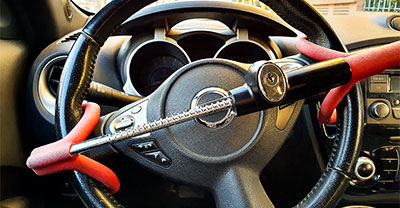What you need to know about catalytic converter theft


0 min. read
The catalytic converter is part of your exhaust system that helps control emissions. Because it contains small amounts of precious metals, thieves may see it as easy money.
Prices for precious metals have decreased over the past few years. But even though the resale price has dropped, many thieves are still looking for them. If you own one of the top-targeted vehicles, it’s worth knowing how to make your car less vulnerable.
Recent catalytic converter theft trends
In 2023, insurance companies in the United States saw declines in catalytic converter thefts. A few key factors have helped slow the trend:
Stricter laws: States are passing more Know Your Customer (KYC) and Anti-Money Laundering (AML) measures.
Stronger enforcement: Police are focusing on prevention and disrupting illegal resale operations.
New federal proposals: Lawmakers are pushing for catalytic converters to be stamped or marked, making stolen parts easier to trace.
Still, the greatest contributing factor is falling precious metal prices. Catalytic converters contain anywhere from 2–15 total grams of palladium, platinum, and rhodium—the precious metals that remove the toxins from engine emissions. Even though they’re no longer getting peak prices, they can still be worth a lot.
Rhodium prices hit nearly $30,000 per ounce at their peak in 2021, but are now worth about $4,500 per ounce. Palladium peaked at around $3,000 per ounce and now sells for about $950 per ounce.*
Criminals often sell stolen catalytic converters to scrap yards, metal dealers, or recycling centers where they can get anywhere from $25 to $300 for a standard model and up to $1,400 for hybrid models* because they contain more metal.
Catalytic converter theft stats and costs
Dairyland®, a brand of the Sentry Insurance Group, began tracking catalytic converter theft claims in 2022. That year, we saw 499 related claims filed across all types of coverage. Since then the numbers have dropped significantly—down to 243 claims in 2023 and just 105 in 2024.*
When you look specifically at comprehensive coverage claims, the drop is even more dramatic*:
2022: 366 catalytic converter-related claims
2023: 129 claims
2024: 37 claims
Many vehicle owners are still dealing with the fallout. Replacement parts are hard to come by, which means longer periods without a vehicle. When you can find the parts, the repairs can cost up to $3,000 in some areas. Many car owners don’t invest in comprehensive coverage, especially for older vehicles, so they’re paying a lot of money out of pocket.
If you opt to drive your vehicle without a catalytic converter, you may face other costs:
Loud exhaust noise, rough acceleration, and reduced power
Possible legal consequences, including fines or impoundment
Increased carbon monoxide levels which can pose health risks
Greater environmental impact from unfiltered emissions
The most targeted vehicles for catalytic converter theft
While these thefts are often crimes of opportunity, certain makes, models, and types of vehicles get targeted more often than others—mostly based on how easy they are to access and how much value their converters hold.
Older vehicles have less sophisticated catalytic converter technology that often uses more palladium, platinum, and rhodium than newer vehicles.
Pickups, SUVs, and hybrid vehicles have catalytic converters with higher concentrations of precious metals.
Vehicles that are higher off the ground—like trucks and SUVs—are easier to slide under and remove the catalytic converter.
Vehicles kept in poorly protected public parking lots, dealerships, or driveways are more at risk since thieves can work with less chance of getting caught.
According to the latest data from Carfax*, the personal vehicles most often targeted nationwide include:
Ford F-150
Ford Explorer
Honda Accord
Toyota Prius
Honda CR-V
Chevrolet Equinox
Toyota Tacoma
Kia Soul
Chevrolet Traverse
Chevrolet Cruze
This list varies depending on where you live. In the Western U.S. for example, the Prius tops the list and two Subaru models—the Forester and the Outback—also make the top ten.
Beyond personal vehicles, be alert for catalytic converter theft if you own a motorhome, box truck, or semi.
Signs your catalytic converter has been stolen
Thieves can remove a catalytic converter in a few minutes. You may not even notice anything was taken, until you start your car. Which is why it’s important to know the warning signs:
It’s harder to start your car or may hesitate before turning over
It’s drivable—but is loud and probably sputters, especially when you accelerate
You may notice a sulfur-like smell coming from the exhaust
Your "check engine" light turns on and stays on
What to do if your catalytic converter is stolen
If your catalytic converter has been stolen, it’s important to document it for insurance. If you carry comprehensive coverage, you may be covered. Here’s what to do:
Report the incident to the police
Take photos of any damage caused by the theft
Notify your insurance company
How to prevent catalytic converter theft
The main strategy for preventing catalytic converter theft is to create a deterrent. Even small precautions can make stealing your catalytic converter more difficult than it’s worth, causing thieves to find easier targets. Here are some anti-theft measures you can take:
1. Park smart
Park in well-lit areas and install motion lights near your driveway.
If possible, park in a locked garage or fenced area.
When out in public, park near security cameras or building entrances.
2. Install a catalytic converter lock or shield
Catalytic converter shields (like CatShield™ or CatClamp®) cover or encase the converter with steel plates or cables, making it harder to cut off.
Some mechanics can create custom-welded cages or brackets.
3. Etch your VIN or license plate number onto the converter
Marking the converter helps law enforcement trace stolen parts.
Some states and shops offer free or low-cost etching programs.
Does car insurance cover catalytic converter theft?
Wondering whether replacing a stolen catalytic converter is covered under your auto insurance policy? In many cases, the policies that cover stolen car parts require comprehensive coverage—which may also cover damages caused by the theft or acts of vandalism.
If your policy only includes collision or liability coverage, a catalytic converter replacement will likely not be covered.
Every policy is different, so it’s a smart move to review your current coverage and ask your provider questions. Contact the Dairyland® team to discuss your options and get a free quote today!

The general information in this blog is for informational or entertainment purposes only. View our blog disclaimer.
*Data accuracy is subject to this article's publication date.










